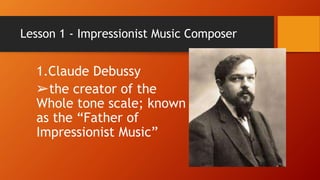Deped grade 10 music quarter 1 - lesson 1 to 4
- 1. MUSIC LESSON 1 TO 4 FIRST QUARTER VIRTUAL CLASSROOM SCHOOL YEAR 2021-2022
- 3. GREETINGS!
- 4. Please type in the chat box how are you feeling today using hashtag moment Example: #pusong inspired
- 5. TITLE: MERON KA BA NITO, NAHANAP MOŌĆ”SHOW MOŌĆ”
- 6. Review:
- 7. 20th Century Music: Impressionist Music
- 8. Lesson 1 - Impressionist Music ŌØ¢ Impressionism is a French Movement that began in the late 19th century to early 20th century. - Most compositions during the Impressionist era were often represented by short, lyrical pieces. - In Western classical music it is the period during the late 19th and 20th centuries, whose music focuses on mood, emotions, arose by the subject rather than a detailed tone picture.
- 9. Lesson 1 - Impressionist Music Rhythm - has free and flexible rhythm. It does not have a clear rhythm, or the rhythm is irregular. Melody - varies from short to long sound and follows a free-flowing lines. Most of the theme of the music was centered on nature, its beauty, and lightness. It also uses the whole tone scale created by Claude Debussy. ........2020-2021 lessons1. first quartermusicModule 1 filesBrahms lullaby.mp4
- 11. Lesson 1 - Impressionist Music Harmony ŌĆō uses parallel chords for color rather than function, adding dissonant notes to chords. Dissonance certainly results from the grating combination of harsh, clashing tones.
- 12. Lesson 1 - Impressionist Music Timbre - is completely unique in impressionistic music, follows the same characteristics that explains the practice and performance of the artists of this style. - woodwind, strings, harp, piano, small chamber
- 13. Lesson 1 - Impressionist Music Composer 1.Claude Debussy Ō×óthe creator of the Whole tone scale; known as the ŌĆ£Father of Impressionist MusicŌĆØ
- 14. Lesson 1 - Impressionist Music Composer 2. Joseph - Maurice Ravel Ō×ó - He used modes types of scales with different moods. - - His music has a tonal center and uses formal structure
- 16. Lesson 2 ŌĆō Expressionism in Music Expressionism is a style of art and soon transcend in music that started in 1905 by German artists. Artists create exaggerated pictures, uses distorted colors and unrealistic objects that shows strong emotions or anger.
- 17. Lesson 2 ŌĆō Expressionism in Music Rhythm - has complex and irregular rhythm due to liberation of form and harmony. Melody - uses distorted melodies and harmonies; uses 12 tone scale created by Arnold Schoenberg.
- 18. Lesson 2 ŌĆō Expressionism in Music Harmony - uses harsh dissonance and atonality (it means that it does not have a tonal center or key. Dynamics - utilizes extreme contrasting dynamics and the pitch range of their instruments. Texture - has a constant change in texture because there is a consistent change in instrumental color making the sound dark and heavier.
- 19. Lesson 2 ŌĆō Expressionism Composer 3. Arnold Franz Walter Schoenberg - His composition involves atonality (composition has no tonal or center key); and makes the music feel more ambiguous and even unsettling
- 20. Lesson 3 ŌĆōAvant Garde Music Avant-garde - a French phrase meaning "vanguard" or (literally, "advance guard"), describes movements of innovation and experimentation in the fields of arts and music. - The Avant Garde artists can be described as a group of people who develop fresh and often very surprising ideas in visual art, literature and culture at large.
- 21. Lesson 3 ŌĆōAvant Garde Music Characteristic of Avant Garde Music: - it breaks various rules and regulations of traditional music and create a new organize sound. - Harmony ŌĆō have a great increase in the use of chords that blur the sense of a stable tonality; have mysterious sound, while diminished chords have an unsettling, dissonant sound.
- 22. Lesson 3 ŌĆōAvant Garde Music Characteristic of Avant Garde Music: - Melody - uses the tone-row, 12-tone, or dodecaphonic music, uses ŌĆśMicro-tonesŌĆÖ and improvisations in compositions.
- 23. Lesson 3 ŌĆōAvant Garde Music Characteristic of Avant Garde Music: - Rhythm - uses polyrhythm which means a rhythm which makes use of two or more different rhythms simultaneously and syncopation which is the shifting of the normal accent, usually by stressing the normally unaccented beats.
- 24. Lesson 3 ŌĆōAvant Garde Music Composer 1. George Gershwin His music is light music, jazz and shows music that linked classical and popular music where he makes use of improvisations, syncopation and polyrhythms.
- 25. Lesson 4 ŌĆōAvant Garde Music Composer 2. Leonard Bernstein - an accomplished pianist before he became famous a conductor also known as ŌĆ£LennyŌĆØ; who bridged the gap between classical music, Broadway musicals, jazz, and rock
- 26. Lesson 4 ŌĆōAvant Garde Music Composer 3. Philip Glass - His works uses displacement of (beats or accents) rhythms. And rely on traditional diatonic scale and harmonies. Uses Diatonic Scale is consisting of seven notes with the first note repeated one octave above the tonic note. Tonic also known as the root, which is the first note of the scale.
- 27. GENERALIZATION. Let us complete the statementŌĆ” 1.Impressionism is ŌĆ”ŌĆ” 2.Expressionism music isŌĆ”ŌĆ” 3.Avant guard Music isŌĆ”. 4.Impressionism composer is ŌĆ” 5.Expressionism composer areŌĆ”. 6.Avant Guard composers areŌĆ”.
- 28. ŌĆó Read the supplemental activities in the MAPEH google classroom then answer the QUIZ given in the classroom classwork.
- 29. PERFORMANCE TASK IN MUSIC ŌĆó Performance Task will be posted next week and will be explained by your MAPEH Subject teacher during online class so donŌĆÖt be absent for you to understand your task.






























